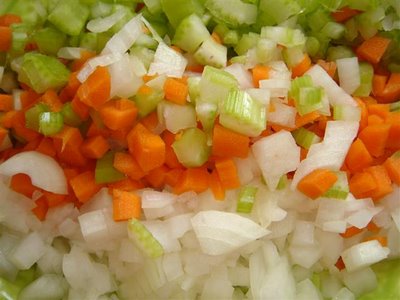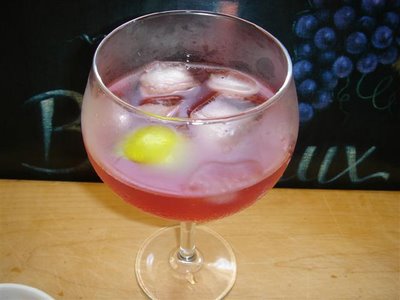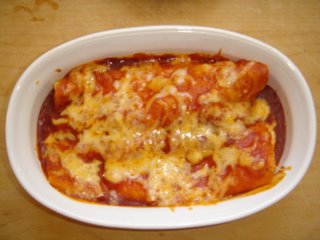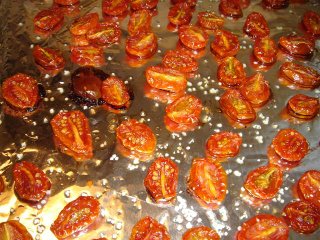A few tips, a little self-confidence, some fresh ingredients and we're easily on our way to a good meal.
 Mirepoix
Mirepoix
Mirepoix, pictured above, consists of diced onions, carrots and celery, a combination of vegetables commonly referred to as aromatics, used as the flavor base for a wide variety of dishes, soups, stews, sauces. If the dish has a Cajun or Creole flair, the carrots are replaced by green peppers and the combination is known as the Holy Trinity. Many Spanish dishes call for a Sofrito base which is garlic, onions and tomatoes. The addition of roasted peppers to the garlic onions and tomatoes gives the sofrito a Caribbean or Latin American flair. Italian dishes are given a flavor kick and a boost of nutrition by adding garlic to the basic mirepoix mix and is then called soffritto. Easy to see that with a little twist, you can quickly become an accomplished continental cook.
The traditional mirepoix ratio is 2:1:1 of onions, celery, carrots. But these veggies are very forgiving and an exact count just isn't necessary to achieve a rich, delicious base for everything from bean soup, to marinara sauce, to slow roasted pork, pot roast or beef stew, just to name some comfort foods that we all occasionally crave. The addition of aromatics, spices and/or herbs, provide depth of flavor and enriched nutrients to simple dishes and invariably generate compliments to the cook.
I often hear people refer to 'doctoring up' some bottled spaghetti sauce. By quickly dicing onions, carrots, celery and with a whiz of the can opener, you can have a pot of marinara sauce simmering away in record time. I often cook a batch of Italian sausage and peppers when I make a pot of sauce. I like to use traditional mirapoix for the sauce, the carrots enrich the flavor tremendously by imparting a sweetness to offset any bitterness from the tomatoes. But with the sausages, I use bell peppers (red and green), onion and minced garlic. Instead of a small dice, I cut wedges of onion and chop the peppers in approximately two inch pieces.

Marinara simmers, sofrito sauté and par-boiled sausages await their turn.
Prepping and cooking both dishes took about an hour. I'd suggest you allow a little longer as I've been making these things for years and may have a slight edge on the prep work. Look at all the meal possibilities I have on hand this week.Perhaps cheese ravioli, using the convenience of frozen Celantanos, with the marinara sauce or some other pasta with sausage and sauce. How about a great sausage and pepper sandwich on a hoagie roll with mozzarella cheese? Wrap in foil, place in a 350 degree oven for 15 minutes. Some of the sauce can be used to make chicken or eggplant Parmesan later in the week. I can freeze half of the sauce for use down the road -- same with the sausage and peppers. Cook once; eat often!
Next time you think about 'doctoring' some bottled spaghetti sauce, give quick marinara sauce a whirl. Here's the recipe for all those who like things spelled out!
Marinara Sauce
Just like Noah's Ark - Two of Each
2 onions, diced; 2 celery stalks, diced; 2 carrots, peeled and diced; 2 cans (28 oz)diced tomatoes (Muir Glen organic are best); 2 bay leaves; salt and pepper
Heat 1/2 cup of EVOO over medium heat, sauté onions and garlic until translucent then add celery and carrots, 1/2 tsp salt and some freshly ground pepper. Sauté until soft then add tomatoes and bay leaves. Simmer uncovered over low heat until sauce thickens. Approximately 45 - 60 minutes. Remove from heat, discard bay leaves, puree with immersion blender or regular blender. Taste for salt and pepper.
**********************************************
Book Nook
I'm playing around with a separate book blog...keep posted. Meanwhile, I did read a couple of good ones this week.
No Good Deeds - Laura Lippman
Black Dog - Stephen Booth
"The man who doesn't read good books has no advantage over the man who can't read them."
- Mark Twain
'Till next time . . . keep on cooking!













.jpg)